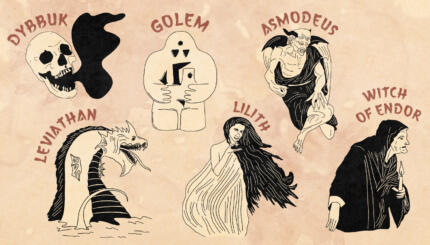Last week, CNN ran a controversial banner: “Alt-Right Founder Questions if Jews are People.”
On the one hand: Move on folks; there’s no news here. The Christian Identity movement has considered us Jews spawn of Satan for years.
On the other hand: It’s shocking to see such words emblazoned across the TV screen. As if this were a legitimate point of political debate like, “Democratic senator questions troop movement.”
Turns out, the content of the banner was false. In the sound bite at issue, alt-right publisher (not founder) Richard Spencer was criticizing “mainstream media,” “republican strategists,” and “political consultants.”
CNN has apologized for the banner, and rightly so: their staff is responsible for both its misleading content and its malicious form. Perhaps they should also reflect on the actual words of the misrepresented quote about the media: “One wonders if these people are people at all, or instead soulless golem animated by some dark power to repeat whatever talking point [satirist] John Oliver stated the night before.”
What is a “golem”? In what sense is it “soul-less”? What “dark power” “animates” it? And what lessons does it hold for journalism today?
The golem is a kind of robot without intelligence. It appears in medieval Jewish folklore as a clay figure brought to life by magic. Its roots, however, are in biblical and Talmudic thought. The book of Genesis depicts God’s material creation of Adam, the first human, from the dust of the earth. Once the Adam’s body is formed, God breathes into it a breath of life, and it becomes a living spirit (Genesis 2:7).
Talmudic stories note that anyone can sculpt clay, but only God can give matter a soul: one sage creates a man who cannot speak, while another creates a calf and promptly eats it for dinner (Sanhedrin 65b). Medieval stories, however, tell of magicians who will not give up. They experiment with powerful words, trying to emulate God’s creative speech. If they place a divine name on the clay, they discover, it will come to life. Each awakened golem, however, has a flaw and must be deactivated by its maker.
As a child, I learned a version of the legend. To protect the Jews of 17th century Prague, Rabbi Judah Loew sculpts a large human figure. On its forehead he carves the Hebrew letters aleph, mem, and tav –the Hebrew word emet, truth. The giant golem is like a one-man army, and his indiscriminate violence gets out of control. On the golem’s forehead Rabbi Loew rubs out the letter aleph, leaving only the Hebrew word met, dead — and the golem’s life ends.
Is the “mainstream media” a soul-less golem? In this story, the golem begins as raw material. Major media outlets certainly have the raw material: access to information and the means to share it. But, says the story, more is needed; truth brings the golem to life. The media, too, must be animated by truth. But even with truth, the golem runs amok. It lacks an inner life, so it cannot self-reflect, self-regulate, or exert moral control. To be fully alive, the media industry must monitor the way it tells truth.
By apologizing, CNN affirmed its commitment to accuracy and responsibility, proving it was no golem. But, in the age of false news, all consumers of news media must watch out for golems. At first glance, such stories look like news, but with a simple rub, their veneer of truth wears off. They are unregulated and immoral. And they are powerful – unless we learn to recognize them for what they are.


